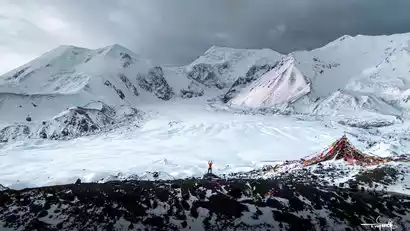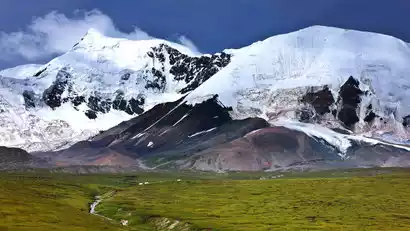Day 1: All over the country → or → Chengdu ★ Gathering day
All day
The first day is a full-day meeting day. Tourists will proceed to the meeting hotel based on their arrival time in Chengdu. At the hotel, provide the front desk with your "China-Travel Note + Name" to check in. We recommend arriving early to stroll around, rest, and experience the slow pace of Chengdu while savoring the various local snacks.
Recommended places to visit: Jinli Ancient Street, Wuhou Temple, Kuanzhai Alley, and Chunxi Road, one of China's top ten commercial streets. Food recommendations: Jinli and Kuanzhai Alley offer a variety of Chengdu snacks, including long shou (long shou), dandan noodles, pig intestine rice noodle soup, and maocai (stir-fried pork belly).


Day 2 Chengdu → Kangding → Xinduqiao → Heishicheng → Yajiang
·morning
After breakfast, we will depart from Chengdu and take the Yakang Expressway to cross the Zheduo Mountain at the border of Han and Tibetan areas. We will see the first snow-capped mountain of this trip from the Zheduotang Observation Deck and then arrive in Kangding, the capital of Ganzi Prefecture.
·afternoon
We continue our journey through Xinduqiao Town to Black Stone City, located near the Gaolusi Mountain Pass. Gazing out at the distant Great Snow Mountain Range, with Gongga Snow Mountain as its main peak, rising from the east, gradually dyed golden in the afterglow of the setting sun.
Afterwards, we left at the right time and went to Yajiang County. The altitude of 2,600 meters will help the body adapt to the plateau environment.


Day 3 Yajiang → Litang → Renkang Ancient Street → Ganzi
·morning
We set out from Yajiang in the morning, passed through the Jianziwan Mountain Tunnel, crossed the Kazila Mountain, and arrived at the world's highest city - Litang.
Arrive at Litang's Changqingchun Khor Monastery, also known as Litang Temple. Consecrated in 1580 by the Third Dalai Lama, Sonam Gyatso, it boasts a rich history and magnificent architecture. You'll also have the opportunity to see the temple's treasures: the golden footprints of the Third and Fifth Dalai Lamas. From this elevated vantage point, you can capture panoramic views of the ancient streets and temple.
Afterwards we went to visit Renkang Ancient Street, which is famous for the Renkang Ancient House, the birthplace of the Seventh Dalai Lama.
·afternoon
We left Litang in the afternoon and arrived at the Ganzi Monastery Observation Deck in time to photograph the sunset. Ganzi Monastery is a Gelugpa monastery located on a hillside near Ganzi County. Its architectural style is a blend of Tibetan and Han styles, and it boasts a history of over 300 years.
Overnight in Ganzi County.


Day 4: Ganzi → Xinlong Hongshan Danxia → Cross the Ganbai Road → Baiyu County
·morning
After breakfast, we'll depart for a drive to explore the hidden gem, Xinlong Red Mountain Danxia, hidden deep within Xinlong, accessible only by off-road vehicles. The Xinlong Danxia landform is vast and diverse in form. Because most of the surrounding peaks rise above the snow line, the Danxia is perpetually covered in snow, bordering the Zhuodala Snow Mountain, creating a unique "gold and silver mountain" landscape.
·afternoon
We continued our journey and passed by Baiyu Temple, a more mysterious Buddhist holy place than Seda. We stopped at the right time to take photos.
We then began to cross the scenic Ganbai Highway, passing the vast Acha grassland along the way, and then entered the Chaqingsongduo White-lipped Deer Nature Reserve, where we had a chance to encounter the first-class protected white-lipped deer.
Check in to Baiyu County in the evening.


Day 5 Baiyu County → Gaden Monastery → Derge Sutra Printing House → Derge County
·morning
Starting from Baiyu, we circled up the river valley. The mountain road rose sharply by 2,000 meters and arrived at Gaden Monastery, the ancestral home of the Nyingma sect, known as "Little Seda", which can only be reached by off-road vehicles. The temple complex is built among the cliffs, stretching continuously, like Seda hanging in the sky, dyeing the valley into a sea of red.
·afternoon
Afterwards, we'll travel to Derge County, the hometown of King Gesar, to visit the sacred Derge Sutra Printing House. We'll be accompanied by a professional guide to delve deeper into the cultural heritage and significance of the Derge Sutra Printing House. This small town has become one of the three major centers of Tibetan culture. Inside, you'll witness the classic printing process and discover rare printed works on literature, science, medicine, and more.


Day 6 Derge → Dangzi Co → Zhaxika Grassland → Songgemani City → Shiqu County
·morning
Starting from Derge, follow National Highway 317 and pass the Queer Mountain Glacier Observation Deck. The majestic, snow-capped Queer Mountain, at 6,168 meters above sea level, towers over ten surrounding peaks at 5,500 meters. There's a saying that goes, "Climbing Queer Mountain is like whipping the sky."
Take an off-road vehicle deep into the heart of northern Gansu and explore Dangzi Co Lake under the Queer Mountain Glacier. The lake surface glows a faint green in the sun, reflecting the image of Queer Mountain. Compared with the closed Xinlu Lake, there are almost no tourists visiting here.
·afternoon
All the way along the Zhaxi Ka grassland in Kang region, the scenery outside the car window keeps changing, wild animals jump over from time to time, and here you can also meet the Yalong River again.
We arrived at Songge Mani City in time for a tour and photography. Legend has it that soldiers built a Mani pile here to pray for the souls of those who died on the battlefield. Later, locals flocked here to pay homage to King Gesar's achievements. The pile grew larger and larger, eventually forming the massive Mani City, 10 meters high and approximately 100 meters long, which continues to attract a constant stream of pilgrims.
Stay in Shiqu County, the "City of the Sun" at night.


7th Tianshiqu → Bagmani Stone Scripture Wall → Maduo
·morning
Departing Shiqu early in the morning, we made our pilgrimage to the Bagh Mani Stone Wall. The wall stretches 1.7 kilometers and contains over 3,000 stone Buddha statues. A lama named "Ba Ge" laid the first Mani stone, and successive generations have since added more, ultimately forming the wall's present scale. We strolled along the wall, deeply experiencing the power of faith.
·afternoon
Afterwards, we took the Gongyu Expressway, bid farewell to Sichuan, entered Qinghai, and checked into Maduo County in the evening.


Day 8 Maduo → Animaqing Mountain → Maqin
·morning
In the morning, we set off to photograph the sacred Amnye Machen Mountain. Regarded by local Tibetans as the dojo of Avalokitesvara, Amnye Machen is considered one of the four sacred mountains of Tibetan Buddhism, along with Mount Kailash in Tibet, Mount Meili in Yunnan, and Gaduo Jowo in Yushu, Qinghai. Composed of 13 connected peaks rising from 5,000 to 6,000 meters above sea level, the main peak, Machen Kangri, stands at 6,282 meters.
·afternoon
The off-road vehicle goes deep into the sacred mountain area, admiring the rolling Animachen Snow Mountain Group along the way, and arrives at the prayer flag worship platform, where you can appreciate the stunning Zagda Glacier and the emerald-like small lake at the foot of the glacier up close.
After worshipping the sacred mountain, we returned to Maqin County to stay overnight.


Day 9 Maqin → Xining ★ Disbandment Day
All day
After breakfast, we leave Maqin and pass by the beautiful Doucuo on the way. The Amnye Machen Snow Mountain stands quietly in the distance. Wild donkeys and Tibetan antelopes run across the plains from time to time. After passing the Orla Mountain Pass, we appreciate the grassland and canyon landscape and return all the way.
Arriving in Xining in the afternoon, we were first transferred to the Xining Railway Station and then to Xining Caojiabao Airport. Everyone bid farewell to the beautiful Northwest with reluctance, according to their train or flight schedules.







